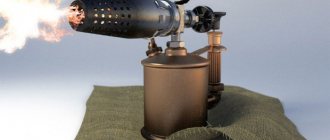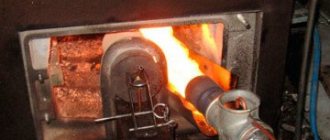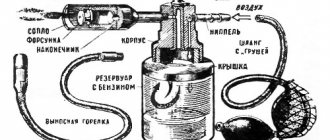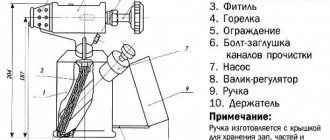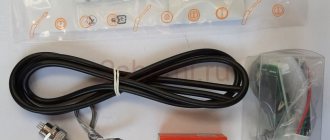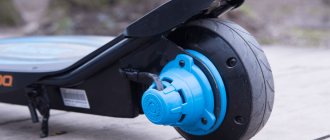PETROL ROAD
The Record kerosene stove lay idle in my garden house for a long time.
At first I wanted to throw it away, because nowadays you rarely find kerosene even in the countryside, but then I changed my mind and decided to switch to a more affordable fuel - gasoline. However, you cannot simply replace kerosene with gasoline. The first one has a high vaporization temperature, so the Record burner is designed in such a way that fuel is supplied to the nozzle not directly from the tank, but through a tube passing above the kerosene stove flame. Here it evaporates and, mixed with air at the outlet of the nozzle, ignites.
Gasoline, with its low vaporization temperature, will instantly boil in a hot tube, which is fraught with an increase in pressure in the tank, an explosion and a fire.
For Record to work reliably and safely, a new burner was required. I machined its parts from steel (but it can also be made from brass). The cap and reflector in the housing socket lie freely, without fastening; They are easy to remove if you need to clean the injector. The latter is protected from clogging by a fine-mesh metal mesh rolled into a roll (fastened with a drop of POS-60 solder).
The torch works in much the same way as a blowtorch. Under the pressure of the air pumped by the pump, gasoline rises to the nozzle and is injected into the space between the cap and the reflector. Here it evaporates, mixes with air, heats up and, exiting through the small holes of the reflector, ignites.
Burner design:
1 - body, 2 - nozzle, 3 - cap, 4 - reflector.
To operate the kerosene stove outdoors, I made a windproof cover from a 0.5 mm thick steel sheet that was placed over the burner. (As a last resort, you can use a suitable tin can, carefully cutting out its lid and bottom.) The height of the casing is approximately equal to the height of the burner body in the operating position, the diameter is slightly larger; the edges are perforated with Ø 8 mm holes in 15 mm increments.
Rice. 2. Windproof cover.
Such a primus is heated in the same way as a kerosene stove, using alcohol, denatured alcohol, gasoline or dry fuel. In inclement weather, it is better to take the latter, crushed and soaked in gasoline.
The burner flame should be pale blue. If it forms a torch, the primus is immediately extinguished and heating is repeated. The same is done when the flame hums and heats up the reflector. This means that the burner parts in the socket are installed incorrectly.
In addition, the safety rules specified in the operating instructions for the kerosene stove should be supplemented: do not use gasoline with an octane number greater than 93; do not pour it into a primus stove that has not cooled down or is running; do not mix with lubricating oils - this does not reduce its fire hazard. Finally, do not use leaded fuels - they are toxic.
Source
Communities › Autonomous Light and Heating for Road Trips › Blog › Fuel for Primus stoves
The most common primus stoves among gasoline ones are the Shmel type family - from 1 to 4.
They work according to the instructions - on motor gasoline... With a little - BUT - when these Primus stoves were designed, gasoline contained a minimum of additives. now the picture is different. Moreover, when some gasoline is burned, the aroma is such that you want to throw the primus far away... and never cook anything else with it or light it. what to fill in this case? If resources allow - despite recommendations - feed Bumblebee with 80-type gasoline or Galosh. Aka Nefras 80/120. It’s hard to say based on the manufacturers who is nicer and who is worse.
The use of Galoshes or 80th will significantly reduce or almost eliminate the formation of soot in the primus burner. This fuel has many advantages... But there are also disadvantages - price and availability. But if there is a separate fuel for the primus with a calculated volume for use, it is better to use it. But if there is not enough or in a critical situation, use gasoline from the car’s tank - if it is possible to drain it from there, of course. Yes, the primus may become clogged with carbon deposits, but at least you will have food and warmth. As an option.
Regarding Americans like COLEMAN - only Galoshes... only hardcore...
As an option - 80 straight-run gasoline. It is cheaper in bulk than Galoshes - but it is not available everywhere... In extreme cases - gasoline from the tank... but if the Primus has a generator tube, its service life on gasoline can be several days, and sometimes several hours of operation. Otherwise, it’s just a generator to be thrown away... It’s practically impossible to revive it or clean it... Its cost after the currency jump is more than.
There are generators WITHOUT a capillary tube... But these are old models and they are not common in our country - which is why they are rarely used. On kerosene - gasoline stoves WITHOUT alterations and modifications - as a rule - DO NOT work.
Kerosene primus stoves of the Record-1 type.
Everything seems clear - they run on kerosene. Type KO-25. Kerosene for lighting... According to the manufacturers - the same Yashim and Vershina... But again, you can take a portion and burn it in a primus... If the smell when burning is disgusting, then the kerosene is of the appropriate quality. Of course, any kerosene, when burned, produces a corresponding exhaust - there are also completely disgusting brands - but everything is relative.
In some circumstances, a primus of the Record-1 type and others of this type may well become... multi-fuel... The simplest design of the burner allows it to work on almost anything that burns... To do this, you need to have replaceable nozzles for the burners with the appropriate diameters for a specific fuel. Without modifications Such primuses are capable of burning gasoline, kerosene, white spirit, solvent, some solvents and degreasers - in extreme cases in the absence of other fuel. You can also use alcohol with an appropriate jet as fuel.
The same white spirit has a more pleasant odor when burned compared to kerosene.
Therefore, in order for the burner to become omnivorous, either the cable is removed from the generator... or maintenance of the burner is done every day after its use with the installation of a jet corresponding to the fuel. Either good fuel like Galoshes... or gas - in the case of an evaporator tube or a generator - is a completely acceptable option. Many burners in their configuration have replaceable jets for different fuels - gas, gasoline, kerosene, diesel fuel - which makes them even more versatile - but for the most part without modification - they also remain demanding on the quality of the fuel - otherwise the resource and time of their operation - can be significantly reduced.
DIY gasoline burner
Gasoline burners quite often help out fishermen. They can be divided into 3 main types:
The latter type of burners is designed to operate on various types of fuel. It just so happened that gasoline devices appeared a little earlier than gas ones. Despite the fact that quite a lot of time has passed since the advent of gas burners, gasoline burners are still used in our time.
Moreover, they are not just used, but used more and more intensively. The thing is that each type of burner has a number of advantages and disadvantages. Under certain conditions, gasoline burners show better results and high efficiency. This article is aimed at introducing readers to the advantages of gasoline burners.
Design and use of a blowtorch
A blowtorch is one of the sought-after tools in the arsenal of any craftsman. And this is not surprising.
With its help, many types of work related to soldering and heating can be performed. Using a blowtorch is very simple, but we must not forget about safety measures.
How to use
Before we talk about how to use it, we need to remember where a blowtorch is generally used. Among the areas of application are the following:
- soldering metal parts using molten solder;
- heating the elements to be joined by welding;
- heating pipes with frozen liquid in the event of malfunctions and accidents on pipelines;
- removal of old paint and varnish coatings from metal and sometimes wooden structures;
- heating rusted joints to facilitate their disassembly;
- heating and cooking food on the go;
- Use a blowtorch with extreme caution to warm up internal combustion engines before starting them in very cold weather.
In almost all cases, the lamp must be used the same way. It is filled with flammable liquid and ignited. The differences relate to the amount of time the flame is exposed to, the adjustment of its intensity and how to properly direct it.
Device and principle of operation
A blowtorch consists of a fuel reservoir, a pump and a burner. The tank stores liquid hydrocarbon fuel. It could be gasoline, kerosene, alcohol.
Gasoline is most often used as the most accessible and cheapest type of fuel. A hermetically sealed filler neck is provided for filling with fuel.
The pump serves to create air pressure in the tank. It is under its influence that the fuel enters the burner, in which combustion occurs, releasing a large amount of heat.
The burner has a rather complex design. The fuel, before reaching the nozzle, passes through a small reservoir that encircles the flame in a ring. At this time, it is heated up so that at the exit from the nozzle it passes into a state close to vapor.
The size of the flame depends on the amount of fuel entering the nozzle and is regulated by a special tap with a needle that closes the outlet. Fuel consumption also depends on the size of the flame.
Preparing for ignition
You need to start using a blowtorch by checking its serviceability and functionality.
During inspection, make sure that all threaded connections on the filler neck and pump are clean and functioning well, while ensuring the tightness of the internal volume of the fuel tank.
The condition of the rubber gaskets also affects the tightness. It is also necessary to pay attention to the ease of rotation of the adjusting screw. It is prohibited to use a faulty blowtorch, as fuel vapors escaping from the tank may ignite.
The housing must be clean and not oily. It is not recommended to use dirty tools, as some oils can also ignite when heated.
To refill the blowtorch without spilling gasoline, you must use a funnel of the appropriate size. The reservoir is filled no more than three quarters so that air remains inside, which will be compressed by the pump, creating pressure.
It is necessary to use only clean fuel without impurities and with a minimum amount of additives.
The adjusting screw is closed before filling. Next, create a slight pressure in the tank by pumping 10-15 times. Now you can use the blowtorch!
Ignition and warming up
To light the lamp, you need to pour a small amount of gasoline into the metal cup provided by the design at the bottom of the burner.
It is ignited with matches or a lighter and, when burned, heats the “jacket” of the burner, inside which the fuel will subsequently be heated.
As the gasoline burns in the cup, you need to slowly open the control valve, pointing the burner at a brick wall or a sheet of fireproof material to speed up the heating of the burner.
The tap must be opened extremely carefully, because fuel that is not heated to the required temperature will splash out and ignite. It is necessary that it falls into the cup.
When the blowtorch burner warms up and the fuel from the nozzle begins to burn with a steady flame, you need to use the pump to increase the pressure in the tank. When working with a blowtorch, you need to make sure that the body does not turn over, otherwise fuel will not flow into the burner.
Video: an example of making such a burner
The best thing in the world is something made with your own hands. It is, like nothing else, pleasing to the eye and extremely pleasant to use. This is explained by the fact that when using such things, we involuntarily remember the production process, which always leaves only pleasant memories, even if some difficulties arose in the process of creating the craft.
For those of us who love to relax in nature, in tents or without them, and at the same time appreciate warmth and comfort, there is one irreplaceable thing on a hike that each of us can easily do ourselves. Such a thing is a camp burner. This homemade product will help you heat a tent without exposing it to the risk of fire, heat up cold food, boil a kettle, and the like. In general, the thing is quite useful, interesting and, most importantly, easy to make and use.
The filler you choose should be placed tightly on the bottom of one of the jars, in a layer of 3-7 centimeters. Next, we put one can on top of the other, so that they fit snugly against each other.
Additionally, we can solder them together, however, in this case the burner will be non-inventory, that is, the filler cannot be replaced, as a result of which it cannot be used more than a few times. Now we just have to punch small holes in the middle of our “lid”, as well as on the sides of the burner, like a gas stove.
Now we have reached the finish line - all we have left to do is set fire to our unit. To do this, it must be filled with a fuel and lubricant - alcohol or acetone is best. It will also work on gasoline or kerosene, but then you will have to get used to the constant soot.
A primus is a small device used for heating small objects or preparing food, which is simply an irreplaceable thing in the country. By the way, a home-made primus stove is practically no different from its factory prototype - it can also be used to prepare and carry out various processes of heating parts. Often, such homemade primus stoves are very popular among avid fishermen who simply cannot imagine their fishing without tasty and aromatic fish soup in nature. Also, do not forget about lovers of hiking, for whom this device is simply an irreplaceable thing that helps them survive even in the most extreme recreational conditions. So, having acquired everything you need, you can safely begin the work process of creating a primus stove.
Initially, you need to prepare the beer cans by carefully sanding them so that all the design and paint are removed from them. After that, making an indent of 2 centimeters from the edge of each can, you need to cut off the bottoms. Glass wool is placed in the bottom of the jar, and then covered with the second bottom of the jar. This is done in such a way that the edges of the bottom, which is located on top, fit as tightly as possible inside the bottom. Now they need to be squeezed well together. As a result, they must be connected very tightly. For additional fixation, you can use regular electrical tape. If you don't have electrical tape at hand, you can replace it with tape. Taking a pushpin that has a long tip, five holes are made in the middle of the upper part of the resulting structure. Also, additional holes are made along the entire perimeter of the circle behind the rim, on which a beer can is usually placed.
Pre-prepared gasoline or kerosene is slowly and carefully poured upward so that it gets inside the device through five holes made in the center. During the process, you need to monitor the stream - it should be slow and uniform. In addition, it is best to pour fuel in small portions until liquid dangling begins to be felt inside the manufactured device. A special structure is made from wire, on which you can then place, for example, a cauldron of suitable size. To do this, on a wire about 60 centimeters long, marks of 25 centimeters are made from the end of one and the other side. After which it is bent down so that it resembles the letter “P”. It is turned over with its back down and bent forward again, making indentations of 10 centimeters on both sides of the existing bends.
Making a mini primus or burner at home
Each of us needs a heating device. Especially if it is small in size, it can be used not only at home, but also outdoors, which will undoubtedly appeal to fans of hiking, camping, fishing, and so on. The mini burner will easily fit in a bag or backpack. A mini burner will be useful for those who take only the most necessary things with them on a hike, since it is smaller in size than ordinary matches.
Making a mini Primus in the video:
In order to make a mini burner or primus at home, we will need absorbent napkins or a sponge, a star jar, an awl, lighter gasoline or medical alcohol, sandpaper or a metal sponge.
Since we will make a burner from a star jar, it will turn out to be very small, which means that it can be called a micro burner.
The first thing we need to do is make holes with an awl around the shiny line of the jar. The distance between the holes should be approximately 2 mm.
After all the holes have been made, we need to take sandpaper or a metal sponge and clean the surface of the jar.
When the jar is cleared of paint, you should take an absorbent napkin, press the bottom of the jar into the napkin and cut a circle along the resulting contour. The same procedure must be done twice to get two even circles. The circles need to be inserted into the jar.
Next, you need to pour lighter gasoline or medical alcohol into the lower part of the jar. When enough alcohol has been poured in, all that remains is to close the lid.
The mini primus or burner is ready. Using an absorbent cloth or sponge will prevent gasoline or rubbing alcohol from leaking out and evaporating quickly.
Attention!!! Follow safety rules when using a mini kerosene stove or burner. Do not open the burner until the fire has been extinguished, and do not keep flammable materials nearby.
In conclusion, here is some information that will be useful when using a mini burner: when using gasoline for lighters, the burner will burn for approximately 2 minutes 30 seconds. If you use 96 percent medical alcohol as fuel, the burner will burn for approximately 4 minutes 10 seconds. The height of the burner flame is approximately 11 centimeters.
This way you can make a mini burner using available materials.
Become the author of the site, publish your own articles, descriptions of homemade products and pay for the text. Read more here.
